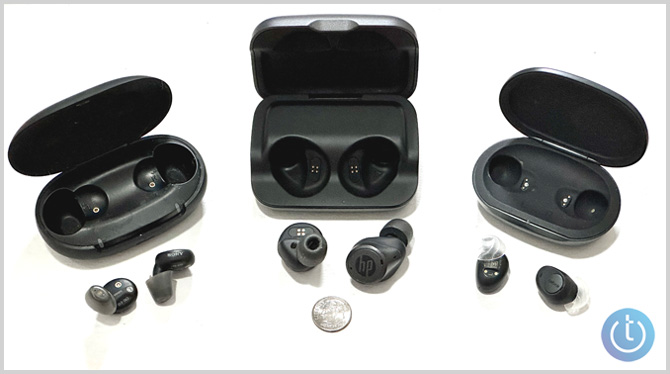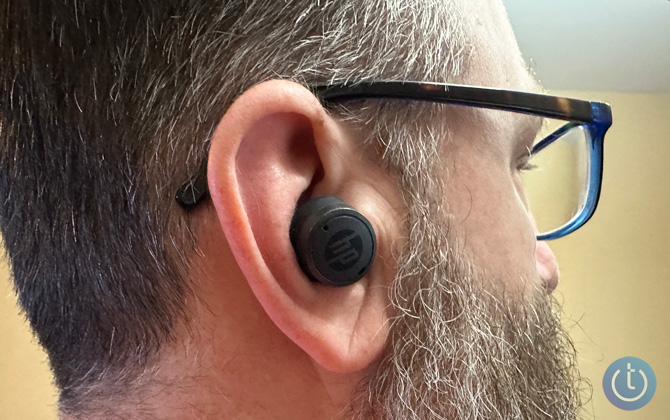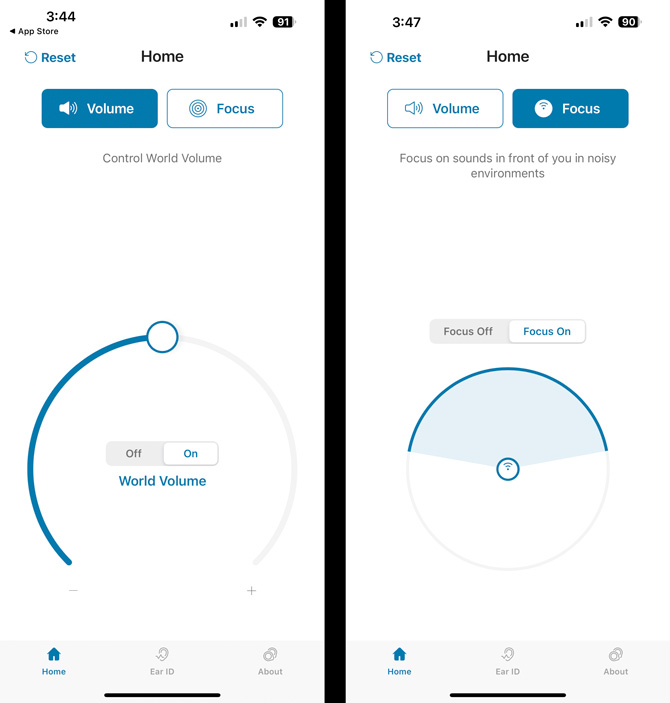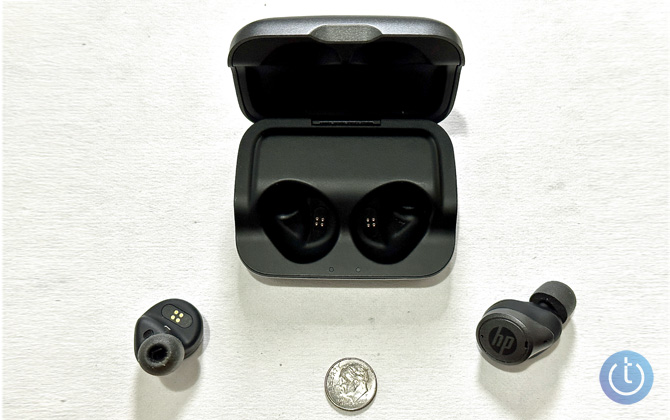We may earn commissions when you buy from links on our site. Why you can trust us.
HP Hearing Pro OTC Hearing Aids: The Best for Music Lovers
Those of us suffering mild to moderate age-related hearing loss don't necessarily want to wear a hearing aid all day, regardless of their comfort or lack of visibility. We only want/need hearing assistance in specific situations, mostly when we need to hear and comprehend voices – when talking to people, watching TV, or attending concerts, for example.
It is this occasional, situational hearing assistance that the new class of Bluetooth-enabled over-the-counter (OTC) hearing aids, such as the HP Hearing Pro "powered" by Nuheara ($699), the subject of this review, as well as the Sony CRE-E10 ($1,200), and the Jabra Enhance Plus ($799), are designed for. All three of these standard-styled in-ear Bluetooth buds offer the features required by the new OTC hearing aid regulations and are currently the only products of their type on the market. They are self-fitting, which means you take an app-based hearing test to configure the buds to your specific hearing loss and are FDA-cleared Class II medical devices. Unlike "normal" hearing aids, even those with Bluetooth to enable hands-free phone conversations, Bluetooth OTC hearing aids double as regular – and high-quality – music streaming earbuds.

From the left, the Sony CRE-E-10, HP Hearing Pro, and Jabra Enhance Plus
The HP Hearing Pro powered by Nuheara are essentially an FDA-cleared self-fitting hearing aid version of the Nuheara IQbuds2 Max ($499), which qualify as personal sound amplification products (PSAP), an FDA hearing assistive device category. As an OTC hearing aid, the Hearing Pro have better speech understanding than the IQbuds2 Max in noisy environments and simplified features and controls for what is assumed to be an older buyer. And of the Bluetooth OTC hearing aid models we've tested, the HP Hearing Pro offer the best overall Bluetooth music listening experience. They are also the only ones with active noise canceling to actually quiet the world, especially helpful while grooving to your tunes.
But how do the HP Hearing Pro stack up as hearing aids against the three current Bluetooth-enabled OTC hearing aids? Overall, they fall in the middle, which still makes them a fine option for those with mild hearing loss seeking situational hearing assistance, especially since it is the cheapest of the three Bluetooth OTC hearing aid options we've tested. But HP and Nuheara's efforts to "simplify" the Hearing Pro for a more senior, assumedly tech-phobic audience lowers its functionality and value.
Ergonomics and set-up
Physically, the HP Hearing Pros buds and case are nearly identical to the Nuheara IQbuds2 Max, which means both buds and case are substantially larger than the buds and case of the Sony CRE-E10 and the Jabra Enhance Plus. The Pros tend to stick out further from your ears compared to the Sony and the Jabra, to the point that, while wearing the Pros, I was half-jokingly informed by a friend that Lt. Uhura wanted her earbuds back.

As with the IQbuds2, you are guided through an app-based hearing test to configure the buds to your specific hearing condition. You also get small, medium, and large sets of both silicone and foam tips. To reduce feedback squealing that is endemic with hearing aids, you'll want tips that completely seal your ear canal, which, for me, meant foam (which aren't as long-term comfortable as the silicone tips I use with the IQbuds2). However, even if you do get what feels like a completely sealed fit, I often heard short/sharp squeals that sounded as if a bird were chirping in the room. And your foam-overstuffed ears will heave a metaphorical sigh of relief when you remove the buds.
The HP Hearing Pro lags far behind in battery life compared to its Bluetooth OTC hearing aid competitors, supplying eight hours of hearing amplification on a single charge or five hours of Bluetooth music streaming – I got 6-7 hours of mixed usage. In comparison, I got 12-14 hours of mixed-use with the Jabra Enhance Plus and an astounding 26 hours with the Sony CRE-E10.
This extreme battery life difference, at least between the HP and the Sony, is largely due to how both OTC hearing aids wirelessly transmit audio between the buds and your phone. The HP uses a regular Bluetooth connection, whereas the Sony uses Bluetooth LE (low energy) and its own audio technology. This saves battery life but lowers both audio quality and the consistency of the Bluetooth LE connection. While the wireless music listening on the Sony can cut in and out in a dense wireless environment (i.e., a crowded Manhattan street), the HP Hearing Pro consistently maintained a solid Bluetooth stream. The HP Pro also lets you turn on active noise canceling, which also eats battery life. In other words, with the Pros, you're sacrificing battery life for a better Bluetooth music experience.
You will find circumstances where battery management is necessary. For instance, if you're out for a few hours listening to music, then enter a longer-term hearing assistive situation, such as watching TV or having dinner with family, you will need to do a quick recharge somewhere in between or find the Pros powering down unexpectedly. The buds get 8 hours of use per charge, and the fully-charged case provides three charges for a total of 32 hours of usage. The buds take 90 minutes to recharge fully, and the case takes three hours, which is average.
One of the great usability aspects of the Nuheara IQbuds2 Max is their on-bud touch controls – one tap of a bud enables you to pause music, turn off noise canceling, and turn on the microphone. To make the HP Hearing Pro "easier" to use for its more senior-targeted audience – and avoid additional FDA usage case clinical studies – HP, unfortunately, removed this on-bud control. Like the Sony and the Jabra, in order to move from music listening to ambient listening, you have to use your music app to pause playback, then switch to the HP Hearing app to turn off noise canceling.
Audio Performance
As hearing aids, the HP Hearing Pro do boost, sharpen, and clarify sounds somewhat more effectively than the IQbuds2 Max, but both are beaten in loudness slightly by the Jabra Enhance Plus and substantially by the Sony CRE-E10. With the Sony, I could turn down the TV sound to barely audible, and by turning up the buds' volume to only less than half of their maximum volume, I could clearly hear and understand the dialog. While the HP Hearing Pro effectively sharpens and cleans muddy sounds and dialog, when you turn their volume up to max, you get only marginally added amplification while increasing the possibility of feedback squeal.
I also found that the Sony CRE-E10 provided a slightly more natural-sounding amplified aural environment than the more shrill-sounding Pro. However, neither matches the natural soundscape provided by OTC hearing aids that don't seal your canal, such as the Eargo 7 (which I'm currently testing) or the Lexie B2 powered by Bose. Their open design allows ambient sound to meld with the amplified sound naturally. Also, gusts or strong breezes are amplified by the Pro and often overcome and then blank out their microphones, which effectively deafens you since you're now essentially wearing earplugs. For instance, I had to remove the Pros when riding in a car with road wind rushing through the open windows.
Just as HP removed bud tap touch controls to "simplify" usage, they also "simplified" the tone controls included with the IQbuds app. Gone are the IQbuds' voice/ambience and bass/treble sliding adjustments, which can audibly improve or compensate for situational acoustics.
Retained is the Nuheara "Focus" control that narrows the microphones' amplification from the usually useless 360 to around 160 degrees in front of you. By comparison, however, Sony's E10 offers more adjustable multi-step and narrower microphone directionality and includes the sliding treble/bass controls that HP removed.

However, music listening via the Pros is far fuller and more robust than the Sony and the Jabra and on par with the excellent IQbuds 2 Max, although the bass response is a bit lighter than I expected. Music playback performance is further enhanced by the Pros' active noise canceling, missing on both the Sony and the Jabra.
Like the Sony and Jabra, HP Hearing Pro's canal-sealing nature also means your voice seems disembodied, and chewing sounds are amplified. Unfortunately, these canal-clogging drawbacks – known as occlusion – seem to be simply the nature of the ear-sealing Bluetooth bud beast.
The bottom line

A huge piece of the decision between the HP Hearing Pro ($699), the Sony CRE-10 ($1,299), and the Jabra Enhance Plus ($799) comes down to price and usage.
If improving your hearing is the critical piece and music listening less so, the Sony CRE-10, with their far louder sound amplification, bass/treble tone controls, and more finely adjustable directional microphones, is the more satisfying choice. However, you'll pay a hefty $600 premium over the HP Hearing Pro for these aural assistive advantages.
If your hearing assistive needs are slight and Bluetooth music listening is as important as situational hearing assistance, then the HP Hearing Pro are your choice. They are the best OTC hearing aids for music lovers.
[Image credit: Stewart Wolpin/Techlicious]
Stewart Wolpin has been writing about consumer electronics for more than 35 years, including news, reviews, analysis and history, and has attended and covered nearly 50 Consumer Electronic Shows and around a dozen IFA shows in Berlin. For the Consumer Technology Association (CTA), he is an elector for and writes the official biographies of the annual CT Hall of Fame inductees, and is the keeper of the industry’s official history.
Discussion 
my hearing is not horrible and i’ve seen the iqbud 2 max for $399 so for me the questions is whether the $300 price difference is worth the improved hearing / degraded functionality. any opinion?
I’m a relatively long-term nuheara iq buds user.
I wear them all my waking hours using the memory foam tips and up until recently had two pairs to change over at lunchtime so that I constantly had a pair on charge. A couple of takeaways for me. They don’t survive. Bike crashes very well, additionally, the touch buttons on the outside can accidentally activate for an unknown reason which can be annoying if you’re listening to something. Secondly, they do not work at all in even the slightest of breezes as the volume is reduced, presumably to protect your hearing from wind noise. however, the connection to your phone and your TV with the optional box and the indoor ability is superb. My next big dilemma is whether or not to go with the HP and the presumed better audio but lose the features of the boost Max or continue with the older model?
















From Joe Dusel on April 26, 2023 :: 5:05 pm
One thing you did not mention was that the HP buds work with Android or iPhone for streaming. Still, based on their large size, reduced features, lower hearing quality and poor battery life it looks like the HP Hearing Pro Version 2 might be worth waiting for if it corrects these deficiencies. This version does not look like a winner to me. I might be interested in the Sony buds, but I am an Android user.
Reply